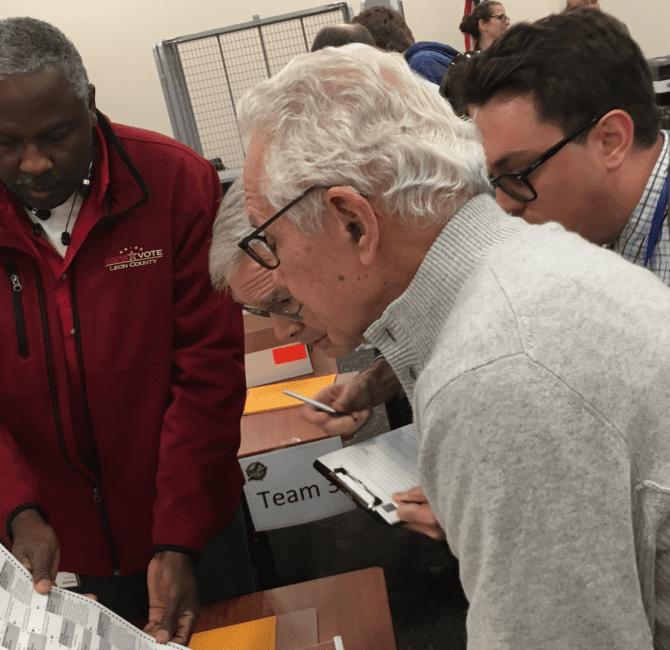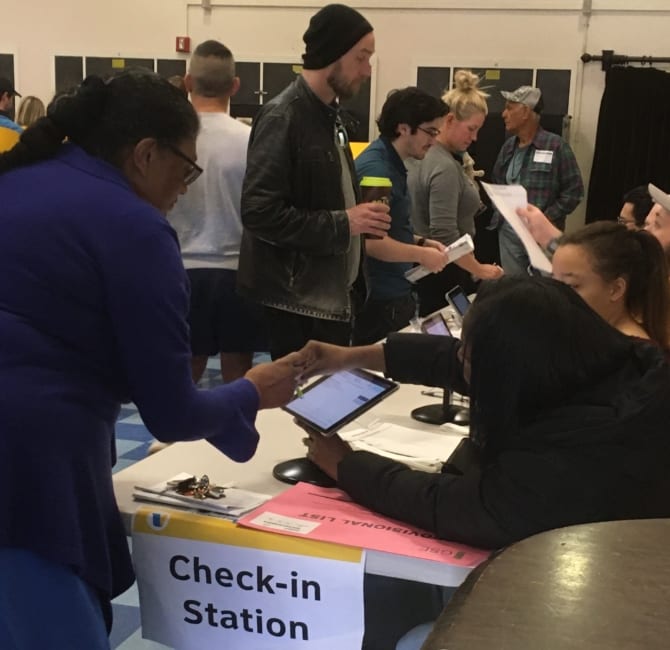Will New Voting Systems Be Ready for 2020’s Early Presidential Contests?

(Photo / Steven Rosenfeld)
Deploying new voting systems in 2020’s presidential caucuses and primaries is turning out to be more complex than regulators overseeing several high-profile states anticipated, raising questions about whether these systems will be ready or should be used.
Last week saw two widely diverging examples of where regulators have delayed approving new voting systems that proponents have been pushing for two Democratic Party presidential caucus states, Iowa and Nevada (the first and third contests), and for one swing state holding an early primary, North Carolina on March 3 (Super Tuesday).
There are different issues facing the party and state regulators overseeing these contests. But they revolve around ensuring that voters’ choices will be accurately recorded and can be verified by the voter, and what form of paper record will be produced for voters and the election administrators — either a ballot summary or a hand-marked ballot.
When the Rules and Bylaws Committee (RBC) of the Democratic National Committee met in Washington on July 30, there was no public discussion about the ongoing review of the telephone voting option that state Democratic parties in Iowa and Nevada want to offer to voters who will not be present at precinct caucuses. Instead, the RBC members received a closed breakfast briefing from the DNC’s technical, security and data staff about the states’ proposed “virtual caucus” systems, which are still being built.
Meanwhile, in North Carolina, where one-third of the state uses paperless voting systems that were to be replaced by 2020, a Democratic-majority state Board of Elections (BOE) changed one part of their certification standards after protests by voting rights activists, raising questions about what kind of system might be deployed for March’s primary.
Activists for voting rights and election transparency don’t want those paperless counties to acquire a new computer system where the voter would input their choices via a touch screen, which, in turn, would produce a paper ballot summary card including bar codes. The system would then scan those summary cards — with the bar codes — to tabulate results. Activists fear the absence of hand-marked ballots can lead to corrupted results.
The state BOE adopted ambiguous wording opposing the use of bar codes on the ballot summary cards on July 29 — although its wording did not oppose using those very same systems to print human-readable ballot summary cards. A day later, the BOE chair was forced to resign after telling a crude joke at a state conference of election officials, most of whom were women. North Carolina’s Democratic governor will appoint a new chair, and the panel is slated to revisit its bar-code ban on August 23.
However, in both instances, there is a common underlying question: Will new, unfamiliar and trustable voting systems be ready for use in 2020’s early presidential contests?
Into the Deep at the DNC
In Democratic Party caucus states, state party officials are publicly optimistic. But there are some big details that have not been worked out, let alone field-tested by analysts who are not the vendor. Those steps come before the public education aspects of introducing any new system. These challenges are not insurmountable, but neither are they trifles.
One topic at the closed DNC Rules Committee briefing, according to those present, was creating a paper record of votes by all caucus participants, including by those using their telephone keypad to rank presidential candidates. The party’s 2020 rules require a voter-verified paper record be created for use in possible recounts.
How to accomplish this task is at the heart of one of the biggest controversies in voting circles today. Activists, from voting rights advocates to election attorneys specializing in recounts, argue there is no substitute for human-marked paper ballots to create a record showing voter intent. However, many voting system manufacturers — and local election officials — don’t want to deal with interpreting sloppy ink marks in recounts. They have embraced an interface that prints out a paper ballot summary interpreting voter intent.
In short, this debate revolves around the question of what a ballot record is going to be in the early 21st century. Because the state Democratic parties in Iowa and Nevada running their presidential caucuses are overseeing a non-governmental process, they are building a new voting infrastructure from rented customized components. The states parties plan to offer a remote voting option via a telephone-keypad and email-based system.
Apart from security concerns surrounding that process, these state parties have to satisfy the DNC’s 2020 requirement for a paper trail for its “virtual caucus” participants.
The virtual voters may end up with an emailed receipt after confirming their choices on their phone. Email is how these voters would receive log-in and password information to vote remotely. In contrast, voters in precinct caucuses will turn in a paper presidential preference card listing their first and final choices. (The caucuses involve ranking the presidential preferences.) Any recount would combine these varying evidence trails.
Securing all of these steps in a statewide caucusing process is formidable, several RBC members said, including one who said that the DNC recently formed an internal technical advisory committee because it was “a bit out of its depth and trying to catch up.”
James Roosevelt III, the RBC co-chair, was careful in describing the ongoing regulatory review after the July 30 Rules Committee meeting.
“The primary topic this morning [at a closed breakfast] was to educate the committee on cybersecurity,” he said, adding that the discussion will continue at its next meeting in San Francisco later this month. “I think a bunch of these things may well come back to the [open] committee in that meeting.”
Cybersecurity is not the only concern. There are questions surrounding the staffing, training and support levels needed for deploying a new voting system. For example, Nevada wants 1,700-plus precinct caucus chairs to use an app to announce the results of that precinct’s virtual vote, and to report the results from the voting in the room.
“I would say that’s still an open question, not so much in principle [using an app] but in demonstrating that the state party will have the resources and the bodies to carry that out,” Roosevelt said.
The DNC Rules Committee has granted conditional approval to Iowa and Nevada for their 2020 plans. Both states are responding to new DNC rules issued last December that require its caucus states to offer a remote voting option to increase participation. But the RBC panel has not yet granted final approval.
Unlike Nevada, Iowa will not be using an app for all of its local precinct caucus chairs, but instead will create four new regional precincts for its virtual voters. Those results will be awarded 10 percent of the night’s allocation of delegates to the process’s next stage.
When asked if the Rules Committee might instruct Nevada to follow Iowa’s template, which appears simpler, Roosevelt said, “I think that’s possible, but I don’t know.”
North Carolina and Other 2020 Acquisitions
At first glance, the drama unfolding at North Carolina’s Board of Elections would appear to have little in common with the DNC’s effort to deploy a new remote voting option in caucus states. Yet both are wrestling with one core issue: what constitutes a paper record when voters use computers (or a phone), but not a pen and paper, to mark the ballot.
The answer to this question of what is the best record showing voter intent — unmediated manmade ink marks or a computer-clarified summary — will come into play when results are close enough to trigger recounts. Whether the public will accept the outcome of that process, will, in part, depend on the vote count evidence presented.
Steeping back, across the country, many states and counties are now acquiring new voting systems for the first time in a dozen or more years. These voting systems may end up being used for a decade or more. That’s why precedents being set are so important.
For example, the Alaska Democratic Party wants to use a smartphone system as a ballot-marking device for its 2020 caucuses. At least one RBC member doesn’t want the DNC to endorse that system, because he opposes internet voting. That system is additionally controversial because it uses technologies that have not yet been federally certified.
In another controversial example, Georgia just announced it would acquire and deploy a new statewide system of ballot-marking devices consisting of “30,000 voting machines, 30,000 printers, 3,500 scanners and 8,000 electronic voter registration terminals,” the Atlanta Journal-Constitution said, “in time for the March 24 presidential preference primary.”
All of the issues that the DNC is facing with introducing remote voting in its nominating contests — from security to usability to recount evidence to public confidence — are also in play in states like Georgia, where it is going with printed ballot summary cards (including bar-coded) instead of hand-marked paper ballots.
But what sets the DNC apart from states like Georgia and North Carolina — where career government officials run elections — is the national and state parties are primarily political organizations, not information technology specialists, and they face the soonest deadlines to stand up new voting systems before the first presidential contests begin.
Also Available on: www.salon.com






